Analysis of Cash-Based and Electronic Payment Systems: Market Research
VerifiedAdded on 2021/04/21
|23
|5573
|338
Report
AI Summary
This market research report provides a comparative analysis of cash-based and electronic payment systems, exploring their advantages, disadvantages, and implementation strategies. It delves into the global shift towards cashless societies, highlighting key indicators that drive this change and the role of governments and financial institutions in promoting electronic payment adoption. The report also covers the technological infrastructure required for successful e-system implementation, including the importance of internet access, secure transaction systems, and the use of various digital payment methods. Furthermore, it addresses the challenges and opportunities associated with transitioning from cash to electronic payments, emphasizing the need for consumer education, fraud prevention, and robust IT infrastructure. The research methodology includes a survey to gather data and analyze the limitations of both payment systems, ultimately providing insights into the future of payment technologies.

Market Research
Paraphrase This Document
Need a fresh take? Get an instant paraphrase of this document with our AI Paraphraser
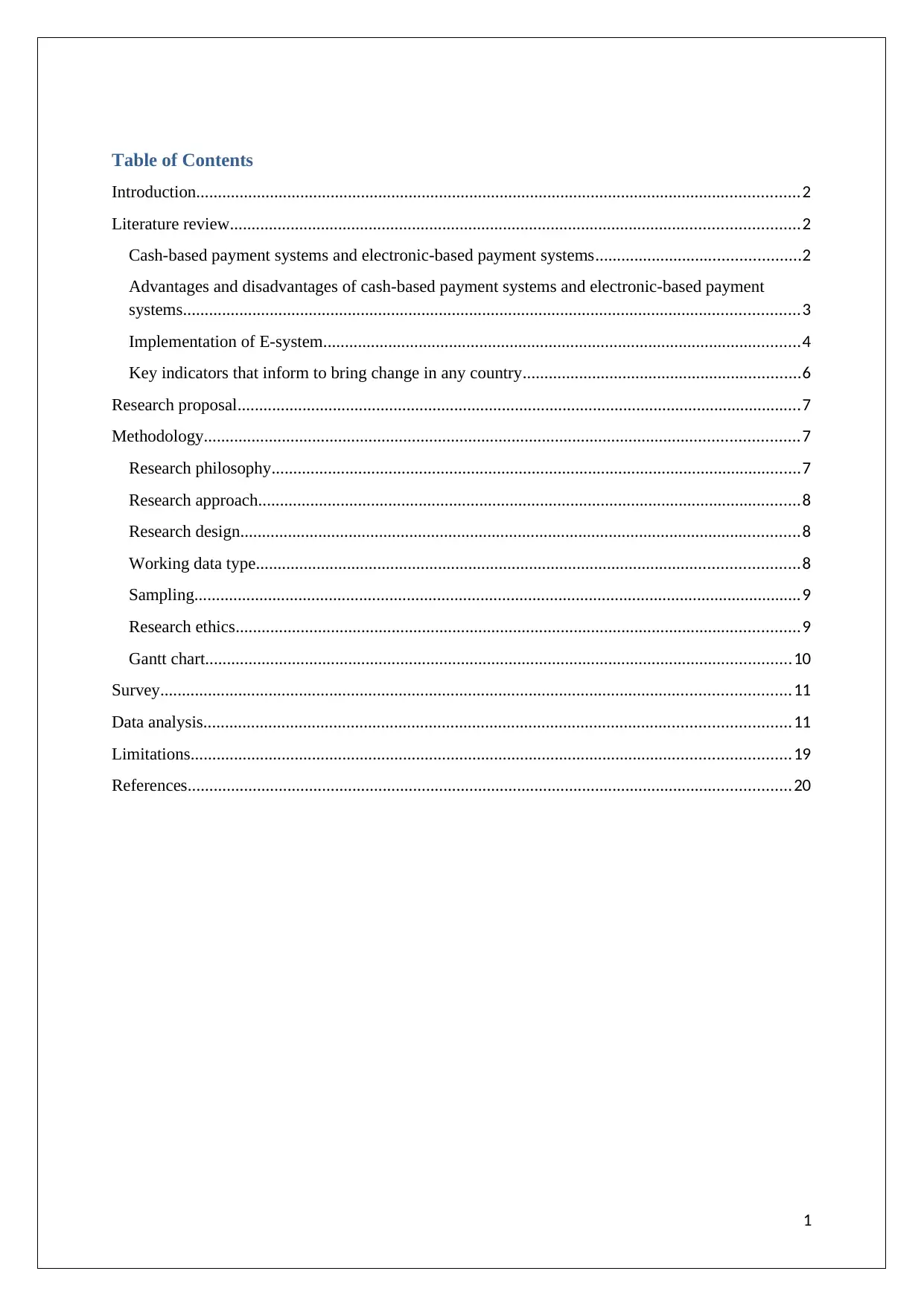
Table of Contents
Introduction...........................................................................................................................................2
Literature review...................................................................................................................................2
Cash-based payment systems and electronic-based payment systems...............................................2
Advantages and disadvantages of cash-based payment systems and electronic-based payment
systems..............................................................................................................................................3
Implementation of E-system..............................................................................................................4
Key indicators that inform to bring change in any country................................................................6
Research proposal..................................................................................................................................7
Methodology.........................................................................................................................................7
Research philosophy..........................................................................................................................7
Research approach.............................................................................................................................8
Research design.................................................................................................................................8
Working data type.............................................................................................................................8
Sampling............................................................................................................................................9
Research ethics..................................................................................................................................9
Gantt chart.......................................................................................................................................10
Survey.................................................................................................................................................11
Data analysis.......................................................................................................................................11
Limitations..........................................................................................................................................19
References...........................................................................................................................................20
1
Introduction...........................................................................................................................................2
Literature review...................................................................................................................................2
Cash-based payment systems and electronic-based payment systems...............................................2
Advantages and disadvantages of cash-based payment systems and electronic-based payment
systems..............................................................................................................................................3
Implementation of E-system..............................................................................................................4
Key indicators that inform to bring change in any country................................................................6
Research proposal..................................................................................................................................7
Methodology.........................................................................................................................................7
Research philosophy..........................................................................................................................7
Research approach.............................................................................................................................8
Research design.................................................................................................................................8
Working data type.............................................................................................................................8
Sampling............................................................................................................................................9
Research ethics..................................................................................................................................9
Gantt chart.......................................................................................................................................10
Survey.................................................................................................................................................11
Data analysis.......................................................................................................................................11
Limitations..........................................................................................................................................19
References...........................................................................................................................................20
1
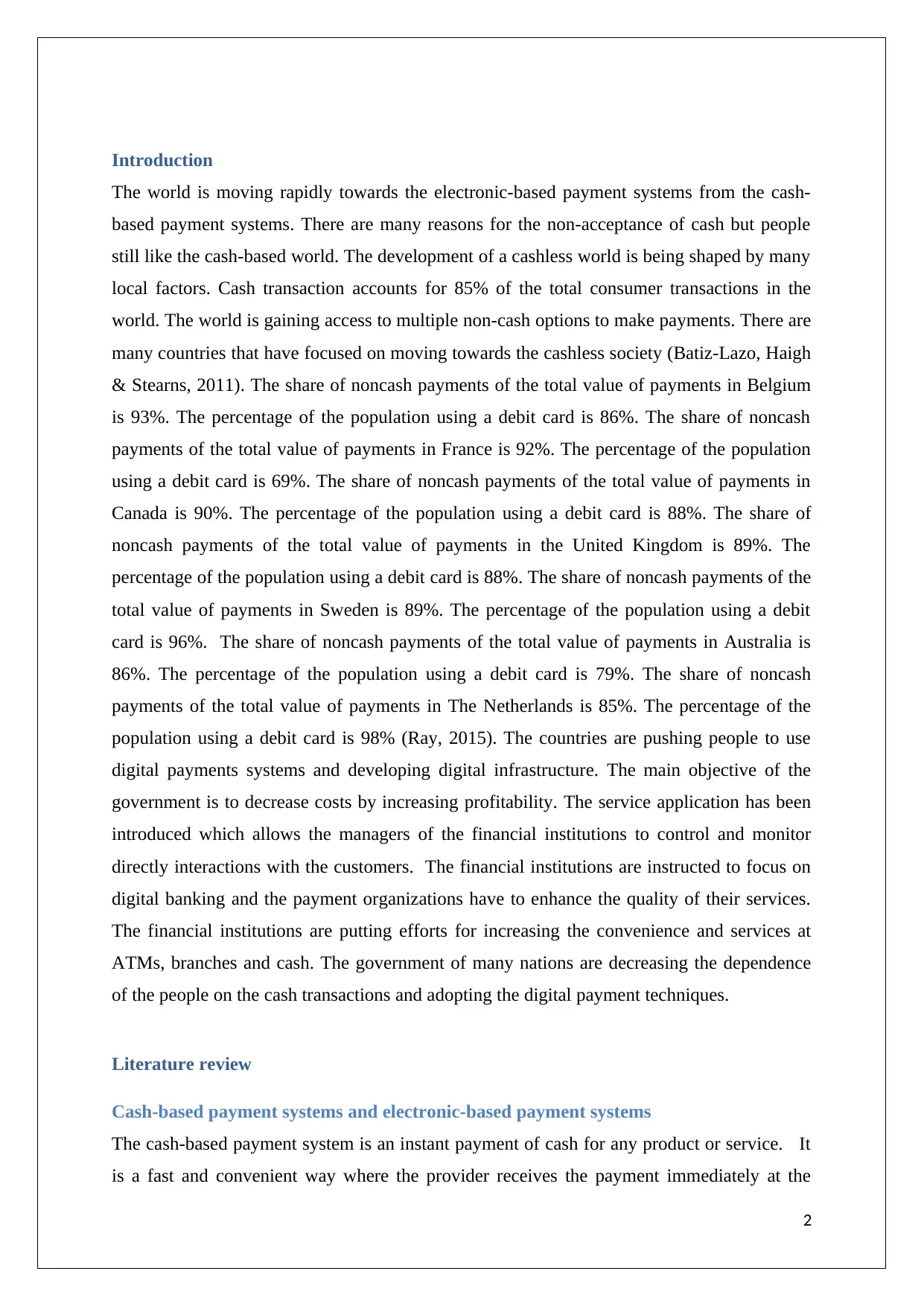
Introduction
The world is moving rapidly towards the electronic-based payment systems from the cash-
based payment systems. There are many reasons for the non-acceptance of cash but people
still like the cash-based world. The development of a cashless world is being shaped by many
local factors. Cash transaction accounts for 85% of the total consumer transactions in the
world. The world is gaining access to multiple non-cash options to make payments. There are
many countries that have focused on moving towards the cashless society (Batiz-Lazo, Haigh
& Stearns, 2011). The share of noncash payments of the total value of payments in Belgium
is 93%. The percentage of the population using a debit card is 86%. The share of noncash
payments of the total value of payments in France is 92%. The percentage of the population
using a debit card is 69%. The share of noncash payments of the total value of payments in
Canada is 90%. The percentage of the population using a debit card is 88%. The share of
noncash payments of the total value of payments in the United Kingdom is 89%. The
percentage of the population using a debit card is 88%. The share of noncash payments of the
total value of payments in Sweden is 89%. The percentage of the population using a debit
card is 96%. The share of noncash payments of the total value of payments in Australia is
86%. The percentage of the population using a debit card is 79%. The share of noncash
payments of the total value of payments in The Netherlands is 85%. The percentage of the
population using a debit card is 98% (Ray, 2015). The countries are pushing people to use
digital payments systems and developing digital infrastructure. The main objective of the
government is to decrease costs by increasing profitability. The service application has been
introduced which allows the managers of the financial institutions to control and monitor
directly interactions with the customers. The financial institutions are instructed to focus on
digital banking and the payment organizations have to enhance the quality of their services.
The financial institutions are putting efforts for increasing the convenience and services at
ATMs, branches and cash. The government of many nations are decreasing the dependence
of the people on the cash transactions and adopting the digital payment techniques.
Literature review
Cash-based payment systems and electronic-based payment systems
The cash-based payment system is an instant payment of cash for any product or service. It
is a fast and convenient way where the provider receives the payment immediately at the
2
The world is moving rapidly towards the electronic-based payment systems from the cash-
based payment systems. There are many reasons for the non-acceptance of cash but people
still like the cash-based world. The development of a cashless world is being shaped by many
local factors. Cash transaction accounts for 85% of the total consumer transactions in the
world. The world is gaining access to multiple non-cash options to make payments. There are
many countries that have focused on moving towards the cashless society (Batiz-Lazo, Haigh
& Stearns, 2011). The share of noncash payments of the total value of payments in Belgium
is 93%. The percentage of the population using a debit card is 86%. The share of noncash
payments of the total value of payments in France is 92%. The percentage of the population
using a debit card is 69%. The share of noncash payments of the total value of payments in
Canada is 90%. The percentage of the population using a debit card is 88%. The share of
noncash payments of the total value of payments in the United Kingdom is 89%. The
percentage of the population using a debit card is 88%. The share of noncash payments of the
total value of payments in Sweden is 89%. The percentage of the population using a debit
card is 96%. The share of noncash payments of the total value of payments in Australia is
86%. The percentage of the population using a debit card is 79%. The share of noncash
payments of the total value of payments in The Netherlands is 85%. The percentage of the
population using a debit card is 98% (Ray, 2015). The countries are pushing people to use
digital payments systems and developing digital infrastructure. The main objective of the
government is to decrease costs by increasing profitability. The service application has been
introduced which allows the managers of the financial institutions to control and monitor
directly interactions with the customers. The financial institutions are instructed to focus on
digital banking and the payment organizations have to enhance the quality of their services.
The financial institutions are putting efforts for increasing the convenience and services at
ATMs, branches and cash. The government of many nations are decreasing the dependence
of the people on the cash transactions and adopting the digital payment techniques.
Literature review
Cash-based payment systems and electronic-based payment systems
The cash-based payment system is an instant payment of cash for any product or service. It
is a fast and convenient way where the provider receives the payment immediately at the
2
⊘ This is a preview!⊘
Do you want full access?
Subscribe today to unlock all pages.

Trusted by 1+ million students worldwide
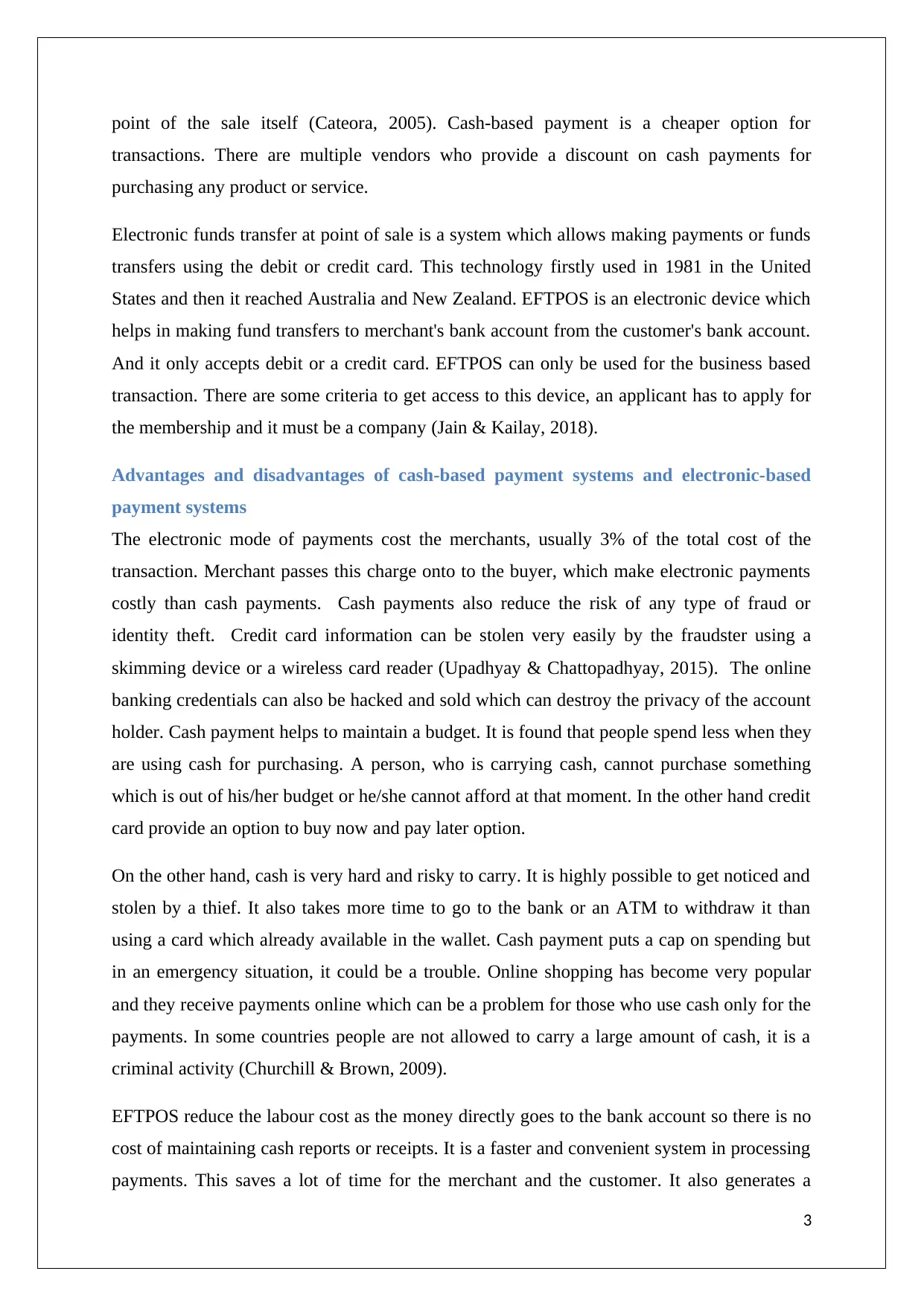
point of the sale itself (Cateora, 2005). Cash-based payment is a cheaper option for
transactions. There are multiple vendors who provide a discount on cash payments for
purchasing any product or service.
Electronic funds transfer at point of sale is a system which allows making payments or funds
transfers using the debit or credit card. This technology firstly used in 1981 in the United
States and then it reached Australia and New Zealand. EFTPOS is an electronic device which
helps in making fund transfers to merchant's bank account from the customer's bank account.
And it only accepts debit or a credit card. EFTPOS can only be used for the business based
transaction. There are some criteria to get access to this device, an applicant has to apply for
the membership and it must be a company (Jain & Kailay, 2018).
Advantages and disadvantages of cash-based payment systems and electronic-based
payment systems
The electronic mode of payments cost the merchants, usually 3% of the total cost of the
transaction. Merchant passes this charge onto to the buyer, which make electronic payments
costly than cash payments. Cash payments also reduce the risk of any type of fraud or
identity theft. Credit card information can be stolen very easily by the fraudster using a
skimming device or a wireless card reader (Upadhyay & Chattopadhyay, 2015). The online
banking credentials can also be hacked and sold which can destroy the privacy of the account
holder. Cash payment helps to maintain a budget. It is found that people spend less when they
are using cash for purchasing. A person, who is carrying cash, cannot purchase something
which is out of his/her budget or he/she cannot afford at that moment. In the other hand credit
card provide an option to buy now and pay later option.
On the other hand, cash is very hard and risky to carry. It is highly possible to get noticed and
stolen by a thief. It also takes more time to go to the bank or an ATM to withdraw it than
using a card which already available in the wallet. Cash payment puts a cap on spending but
in an emergency situation, it could be a trouble. Online shopping has become very popular
and they receive payments online which can be a problem for those who use cash only for the
payments. In some countries people are not allowed to carry a large amount of cash, it is a
criminal activity (Churchill & Brown, 2009).
EFTPOS reduce the labour cost as the money directly goes to the bank account so there is no
cost of maintaining cash reports or receipts. It is a faster and convenient system in processing
payments. This saves a lot of time for the merchant and the customer. It also generates a
3
transactions. There are multiple vendors who provide a discount on cash payments for
purchasing any product or service.
Electronic funds transfer at point of sale is a system which allows making payments or funds
transfers using the debit or credit card. This technology firstly used in 1981 in the United
States and then it reached Australia and New Zealand. EFTPOS is an electronic device which
helps in making fund transfers to merchant's bank account from the customer's bank account.
And it only accepts debit or a credit card. EFTPOS can only be used for the business based
transaction. There are some criteria to get access to this device, an applicant has to apply for
the membership and it must be a company (Jain & Kailay, 2018).
Advantages and disadvantages of cash-based payment systems and electronic-based
payment systems
The electronic mode of payments cost the merchants, usually 3% of the total cost of the
transaction. Merchant passes this charge onto to the buyer, which make electronic payments
costly than cash payments. Cash payments also reduce the risk of any type of fraud or
identity theft. Credit card information can be stolen very easily by the fraudster using a
skimming device or a wireless card reader (Upadhyay & Chattopadhyay, 2015). The online
banking credentials can also be hacked and sold which can destroy the privacy of the account
holder. Cash payment helps to maintain a budget. It is found that people spend less when they
are using cash for purchasing. A person, who is carrying cash, cannot purchase something
which is out of his/her budget or he/she cannot afford at that moment. In the other hand credit
card provide an option to buy now and pay later option.
On the other hand, cash is very hard and risky to carry. It is highly possible to get noticed and
stolen by a thief. It also takes more time to go to the bank or an ATM to withdraw it than
using a card which already available in the wallet. Cash payment puts a cap on spending but
in an emergency situation, it could be a trouble. Online shopping has become very popular
and they receive payments online which can be a problem for those who use cash only for the
payments. In some countries people are not allowed to carry a large amount of cash, it is a
criminal activity (Churchill & Brown, 2009).
EFTPOS reduce the labour cost as the money directly goes to the bank account so there is no
cost of maintaining cash reports or receipts. It is a faster and convenient system in processing
payments. This saves a lot of time for the merchant and the customer. It also generates a
3
Paraphrase This Document
Need a fresh take? Get an instant paraphrase of this document with our AI Paraphraser
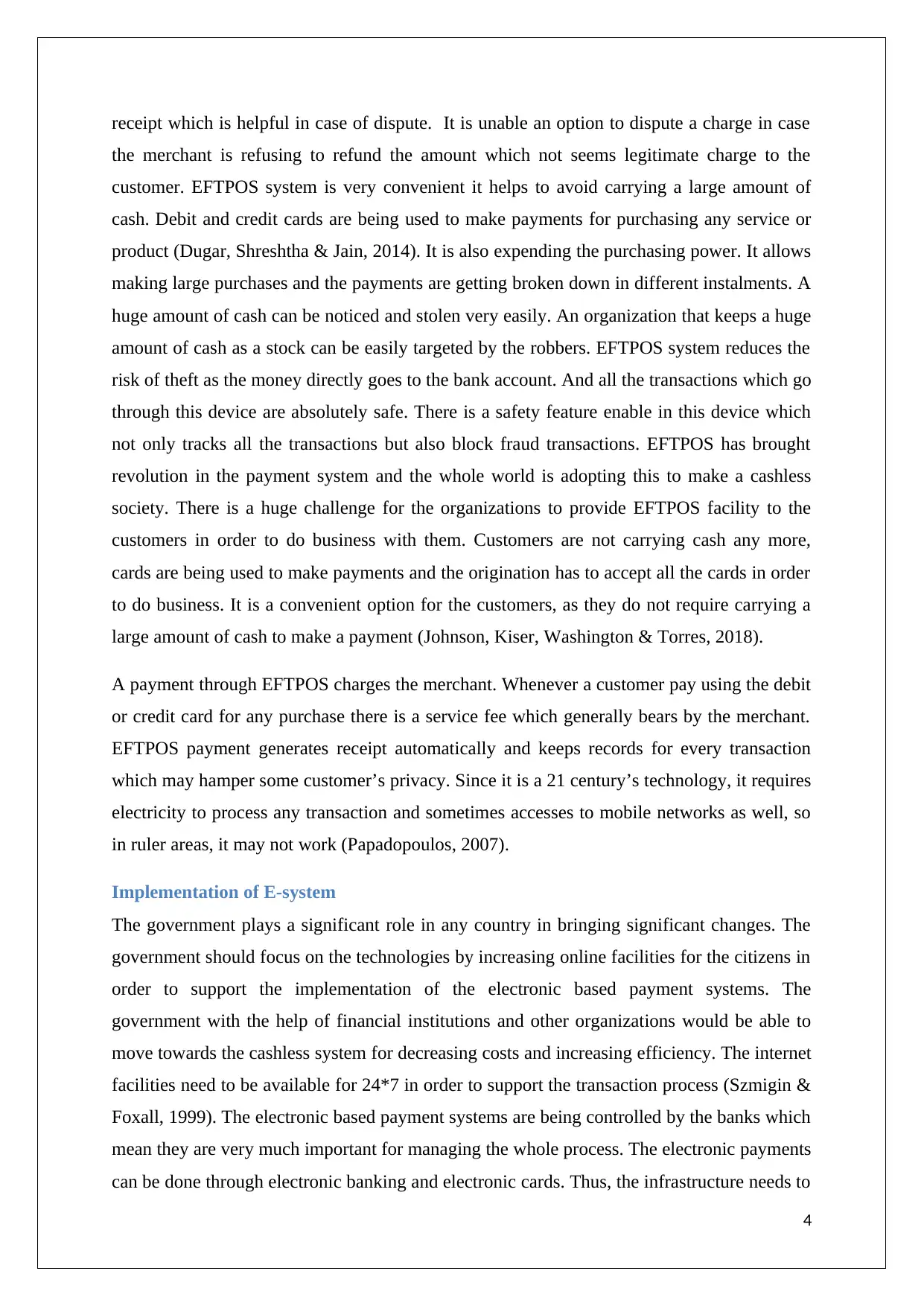
receipt which is helpful in case of dispute. It is unable an option to dispute a charge in case
the merchant is refusing to refund the amount which not seems legitimate charge to the
customer. EFTPOS system is very convenient it helps to avoid carrying a large amount of
cash. Debit and credit cards are being used to make payments for purchasing any service or
product (Dugar, Shreshtha & Jain, 2014). It is also expending the purchasing power. It allows
making large purchases and the payments are getting broken down in different instalments. A
huge amount of cash can be noticed and stolen very easily. An organization that keeps a huge
amount of cash as a stock can be easily targeted by the robbers. EFTPOS system reduces the
risk of theft as the money directly goes to the bank account. And all the transactions which go
through this device are absolutely safe. There is a safety feature enable in this device which
not only tracks all the transactions but also block fraud transactions. EFTPOS has brought
revolution in the payment system and the whole world is adopting this to make a cashless
society. There is a huge challenge for the organizations to provide EFTPOS facility to the
customers in order to do business with them. Customers are not carrying cash any more,
cards are being used to make payments and the origination has to accept all the cards in order
to do business. It is a convenient option for the customers, as they do not require carrying a
large amount of cash to make a payment (Johnson, Kiser, Washington & Torres, 2018).
A payment through EFTPOS charges the merchant. Whenever a customer pay using the debit
or credit card for any purchase there is a service fee which generally bears by the merchant.
EFTPOS payment generates receipt automatically and keeps records for every transaction
which may hamper some customer’s privacy. Since it is a 21 century’s technology, it requires
electricity to process any transaction and sometimes accesses to mobile networks as well, so
in ruler areas, it may not work (Papadopoulos, 2007).
Implementation of E-system
The government plays a significant role in any country in bringing significant changes. The
government should focus on the technologies by increasing online facilities for the citizens in
order to support the implementation of the electronic based payment systems. The
government with the help of financial institutions and other organizations would be able to
move towards the cashless system for decreasing costs and increasing efficiency. The internet
facilities need to be available for 24*7 in order to support the transaction process (Szmigin &
Foxall, 1999). The electronic based payment systems are being controlled by the banks which
mean they are very much important for managing the whole process. The electronic payments
can be done through electronic banking and electronic cards. Thus, the infrastructure needs to
4
the merchant is refusing to refund the amount which not seems legitimate charge to the
customer. EFTPOS system is very convenient it helps to avoid carrying a large amount of
cash. Debit and credit cards are being used to make payments for purchasing any service or
product (Dugar, Shreshtha & Jain, 2014). It is also expending the purchasing power. It allows
making large purchases and the payments are getting broken down in different instalments. A
huge amount of cash can be noticed and stolen very easily. An organization that keeps a huge
amount of cash as a stock can be easily targeted by the robbers. EFTPOS system reduces the
risk of theft as the money directly goes to the bank account. And all the transactions which go
through this device are absolutely safe. There is a safety feature enable in this device which
not only tracks all the transactions but also block fraud transactions. EFTPOS has brought
revolution in the payment system and the whole world is adopting this to make a cashless
society. There is a huge challenge for the organizations to provide EFTPOS facility to the
customers in order to do business with them. Customers are not carrying cash any more,
cards are being used to make payments and the origination has to accept all the cards in order
to do business. It is a convenient option for the customers, as they do not require carrying a
large amount of cash to make a payment (Johnson, Kiser, Washington & Torres, 2018).
A payment through EFTPOS charges the merchant. Whenever a customer pay using the debit
or credit card for any purchase there is a service fee which generally bears by the merchant.
EFTPOS payment generates receipt automatically and keeps records for every transaction
which may hamper some customer’s privacy. Since it is a 21 century’s technology, it requires
electricity to process any transaction and sometimes accesses to mobile networks as well, so
in ruler areas, it may not work (Papadopoulos, 2007).
Implementation of E-system
The government plays a significant role in any country in bringing significant changes. The
government should focus on the technologies by increasing online facilities for the citizens in
order to support the implementation of the electronic based payment systems. The
government with the help of financial institutions and other organizations would be able to
move towards the cashless system for decreasing costs and increasing efficiency. The internet
facilities need to be available for 24*7 in order to support the transaction process (Szmigin &
Foxall, 1999). The electronic based payment systems are being controlled by the banks which
mean they are very much important for managing the whole process. The electronic payments
can be done through electronic banking and electronic cards. Thus, the infrastructure needs to
4

be developed focusing on implementation of transaction systems for the convenience of the
people. The electronic payment systems should be available in each store of the market.
The government of the country should ensure that there should be no system failure and if
occurs then there should organizations who would be responsible to manage the situation.
The main focus would be that the citizens should not face any kind of problem while they
carry out their payment process. The use of plastic cards (credit and debit cards), SMS
payment, internet banking, virtual currency, a virtual wallet and electronic cards should be
encouraged among people of the country. The technological revolution in the field of
communication and information has supported the improvement and development of cashless
instruments and applications for both organizations and individuals (Wakamori & Welte,
2017). The investment should be made in the development of 3G/4G networks, QR code,
NFC, smartphones and Wi-Fi in order to speed up the flow of data and information. The flow
of information is safer, easier and faster which enhances the productivity of the nation. The e-
transfer infrastructure needs to be more efficient in order to avoid any kind of problem that
may arise during the whole process. The availability of competitive marketplace, dynamic
business environment and affordable products are significant factors for the implementation
of the electronic based payment system within the nation.
The role of government will not be limited to only individuals but also applicable to society,
family and the entire and nation. The government has to identify the basic needs of the
citizens which will help to implement the e-systems within the nation. Banking is considered
to be the backbone of the economy and it acts as a bridge between organizations and
customers. The banking system is being dependent on human skills and knowledge for
carrying basic functions such as posting, journal, ledger and trial balance creation. The
banking system needs to be very efficient and advanced for ensuring smooth functioning of
the process (Worthington, 1995). The citizens need to be provided with adequate knowledge
about the use of the electronic based payment system and its benefits. The digital transactions
will assist to solve many problems of the citizens in the country. The transfer of money and
electronic exchange can be carried out with the assistance of electronic devices such as cards,
computers and phone. Thus, the government can invest into the economy for developing
infrastructure (Borzekowski & Kiser, 2008).
5
people. The electronic payment systems should be available in each store of the market.
The government of the country should ensure that there should be no system failure and if
occurs then there should organizations who would be responsible to manage the situation.
The main focus would be that the citizens should not face any kind of problem while they
carry out their payment process. The use of plastic cards (credit and debit cards), SMS
payment, internet banking, virtual currency, a virtual wallet and electronic cards should be
encouraged among people of the country. The technological revolution in the field of
communication and information has supported the improvement and development of cashless
instruments and applications for both organizations and individuals (Wakamori & Welte,
2017). The investment should be made in the development of 3G/4G networks, QR code,
NFC, smartphones and Wi-Fi in order to speed up the flow of data and information. The flow
of information is safer, easier and faster which enhances the productivity of the nation. The e-
transfer infrastructure needs to be more efficient in order to avoid any kind of problem that
may arise during the whole process. The availability of competitive marketplace, dynamic
business environment and affordable products are significant factors for the implementation
of the electronic based payment system within the nation.
The role of government will not be limited to only individuals but also applicable to society,
family and the entire and nation. The government has to identify the basic needs of the
citizens which will help to implement the e-systems within the nation. Banking is considered
to be the backbone of the economy and it acts as a bridge between organizations and
customers. The banking system is being dependent on human skills and knowledge for
carrying basic functions such as posting, journal, ledger and trial balance creation. The
banking system needs to be very efficient and advanced for ensuring smooth functioning of
the process (Worthington, 1995). The citizens need to be provided with adequate knowledge
about the use of the electronic based payment system and its benefits. The digital transactions
will assist to solve many problems of the citizens in the country. The transfer of money and
electronic exchange can be carried out with the assistance of electronic devices such as cards,
computers and phone. Thus, the government can invest into the economy for developing
infrastructure (Borzekowski & Kiser, 2008).
5
⊘ This is a preview!⊘
Do you want full access?
Subscribe today to unlock all pages.

Trusted by 1+ million students worldwide
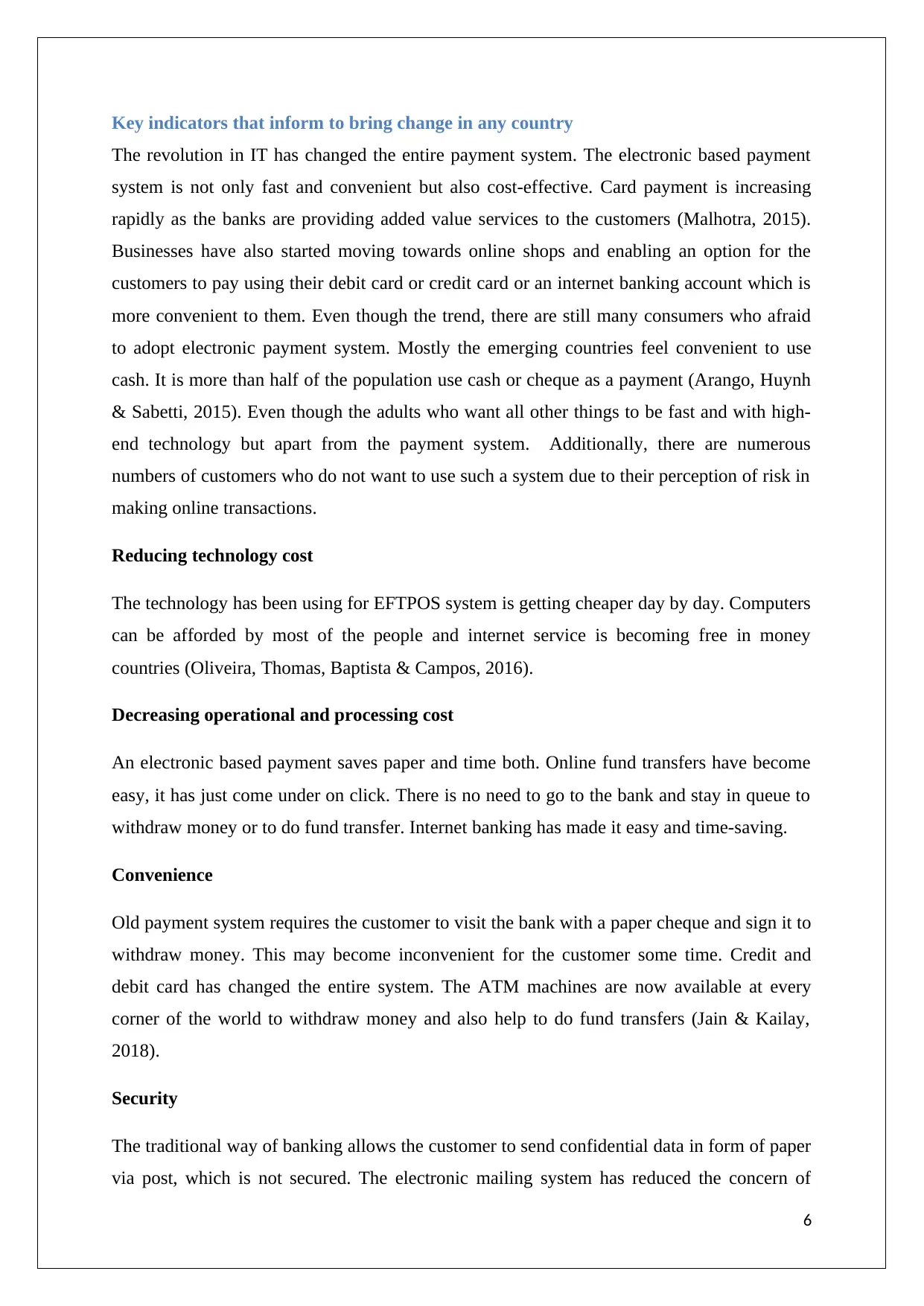
Key indicators that inform to bring change in any country
The revolution in IT has changed the entire payment system. The electronic based payment
system is not only fast and convenient but also cost-effective. Card payment is increasing
rapidly as the banks are providing added value services to the customers (Malhotra, 2015).
Businesses have also started moving towards online shops and enabling an option for the
customers to pay using their debit card or credit card or an internet banking account which is
more convenient to them. Even though the trend, there are still many consumers who afraid
to adopt electronic payment system. Mostly the emerging countries feel convenient to use
cash. It is more than half of the population use cash or cheque as a payment (Arango, Huynh
& Sabetti, 2015). Even though the adults who want all other things to be fast and with high-
end technology but apart from the payment system. Additionally, there are numerous
numbers of customers who do not want to use such a system due to their perception of risk in
making online transactions.
Reducing technology cost
The technology has been using for EFTPOS system is getting cheaper day by day. Computers
can be afforded by most of the people and internet service is becoming free in money
countries (Oliveira, Thomas, Baptista & Campos, 2016).
Decreasing operational and processing cost
An electronic based payment saves paper and time both. Online fund transfers have become
easy, it has just come under on click. There is no need to go to the bank and stay in queue to
withdraw money or to do fund transfer. Internet banking has made it easy and time-saving.
Convenience
Old payment system requires the customer to visit the bank with a paper cheque and sign it to
withdraw money. This may become inconvenient for the customer some time. Credit and
debit card has changed the entire system. The ATM machines are now available at every
corner of the world to withdraw money and also help to do fund transfers (Jain & Kailay,
2018).
Security
The traditional way of banking allows the customer to send confidential data in form of paper
via post, which is not secured. The electronic mailing system has reduced the concern of
6
The revolution in IT has changed the entire payment system. The electronic based payment
system is not only fast and convenient but also cost-effective. Card payment is increasing
rapidly as the banks are providing added value services to the customers (Malhotra, 2015).
Businesses have also started moving towards online shops and enabling an option for the
customers to pay using their debit card or credit card or an internet banking account which is
more convenient to them. Even though the trend, there are still many consumers who afraid
to adopt electronic payment system. Mostly the emerging countries feel convenient to use
cash. It is more than half of the population use cash or cheque as a payment (Arango, Huynh
& Sabetti, 2015). Even though the adults who want all other things to be fast and with high-
end technology but apart from the payment system. Additionally, there are numerous
numbers of customers who do not want to use such a system due to their perception of risk in
making online transactions.
Reducing technology cost
The technology has been using for EFTPOS system is getting cheaper day by day. Computers
can be afforded by most of the people and internet service is becoming free in money
countries (Oliveira, Thomas, Baptista & Campos, 2016).
Decreasing operational and processing cost
An electronic based payment saves paper and time both. Online fund transfers have become
easy, it has just come under on click. There is no need to go to the bank and stay in queue to
withdraw money or to do fund transfer. Internet banking has made it easy and time-saving.
Convenience
Old payment system requires the customer to visit the bank with a paper cheque and sign it to
withdraw money. This may become inconvenient for the customer some time. Credit and
debit card has changed the entire system. The ATM machines are now available at every
corner of the world to withdraw money and also help to do fund transfers (Jain & Kailay,
2018).
Security
The traditional way of banking allows the customer to send confidential data in form of paper
via post, which is not secured. The electronic mailing system has reduced the concern of
6
Paraphrase This Document
Need a fresh take? Get an instant paraphrase of this document with our AI Paraphraser
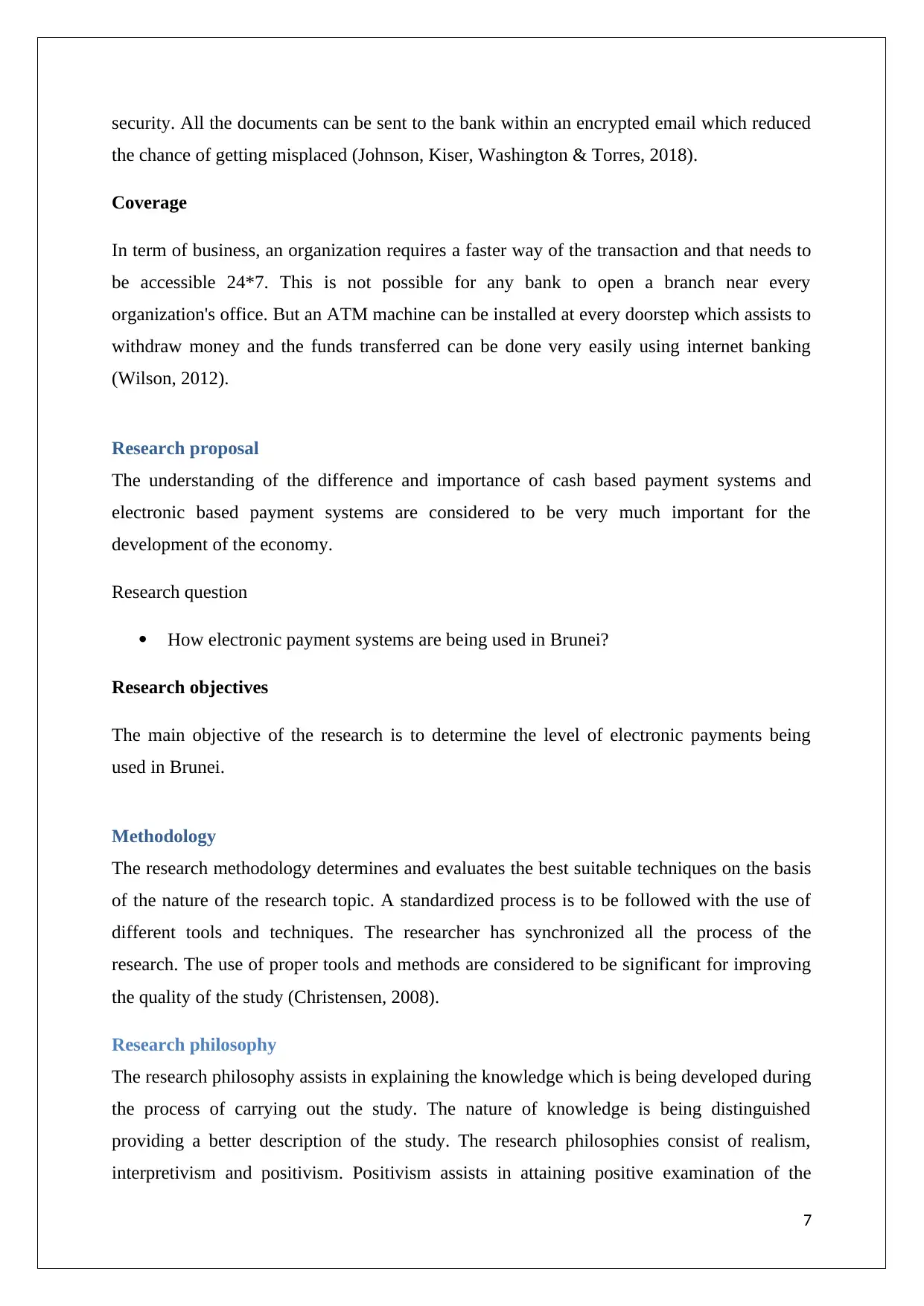
security. All the documents can be sent to the bank within an encrypted email which reduced
the chance of getting misplaced (Johnson, Kiser, Washington & Torres, 2018).
Coverage
In term of business, an organization requires a faster way of the transaction and that needs to
be accessible 24*7. This is not possible for any bank to open a branch near every
organization's office. But an ATM machine can be installed at every doorstep which assists to
withdraw money and the funds transferred can be done very easily using internet banking
(Wilson, 2012).
Research proposal
The understanding of the difference and importance of cash based payment systems and
electronic based payment systems are considered to be very much important for the
development of the economy.
Research question
How electronic payment systems are being used in Brunei?
Research objectives
The main objective of the research is to determine the level of electronic payments being
used in Brunei.
Methodology
The research methodology determines and evaluates the best suitable techniques on the basis
of the nature of the research topic. A standardized process is to be followed with the use of
different tools and techniques. The researcher has synchronized all the process of the
research. The use of proper tools and methods are considered to be significant for improving
the quality of the study (Christensen, 2008).
Research philosophy
The research philosophy assists in explaining the knowledge which is being developed during
the process of carrying out the study. The nature of knowledge is being distinguished
providing a better description of the study. The research philosophies consist of realism,
interpretivism and positivism. Positivism assists in attaining positive examination of the
7
the chance of getting misplaced (Johnson, Kiser, Washington & Torres, 2018).
Coverage
In term of business, an organization requires a faster way of the transaction and that needs to
be accessible 24*7. This is not possible for any bank to open a branch near every
organization's office. But an ATM machine can be installed at every doorstep which assists to
withdraw money and the funds transferred can be done very easily using internet banking
(Wilson, 2012).
Research proposal
The understanding of the difference and importance of cash based payment systems and
electronic based payment systems are considered to be very much important for the
development of the economy.
Research question
How electronic payment systems are being used in Brunei?
Research objectives
The main objective of the research is to determine the level of electronic payments being
used in Brunei.
Methodology
The research methodology determines and evaluates the best suitable techniques on the basis
of the nature of the research topic. A standardized process is to be followed with the use of
different tools and techniques. The researcher has synchronized all the process of the
research. The use of proper tools and methods are considered to be significant for improving
the quality of the study (Christensen, 2008).
Research philosophy
The research philosophy assists in explaining the knowledge which is being developed during
the process of carrying out the study. The nature of knowledge is being distinguished
providing a better description of the study. The research philosophies consist of realism,
interpretivism and positivism. Positivism assists in attaining positive examination of the
7
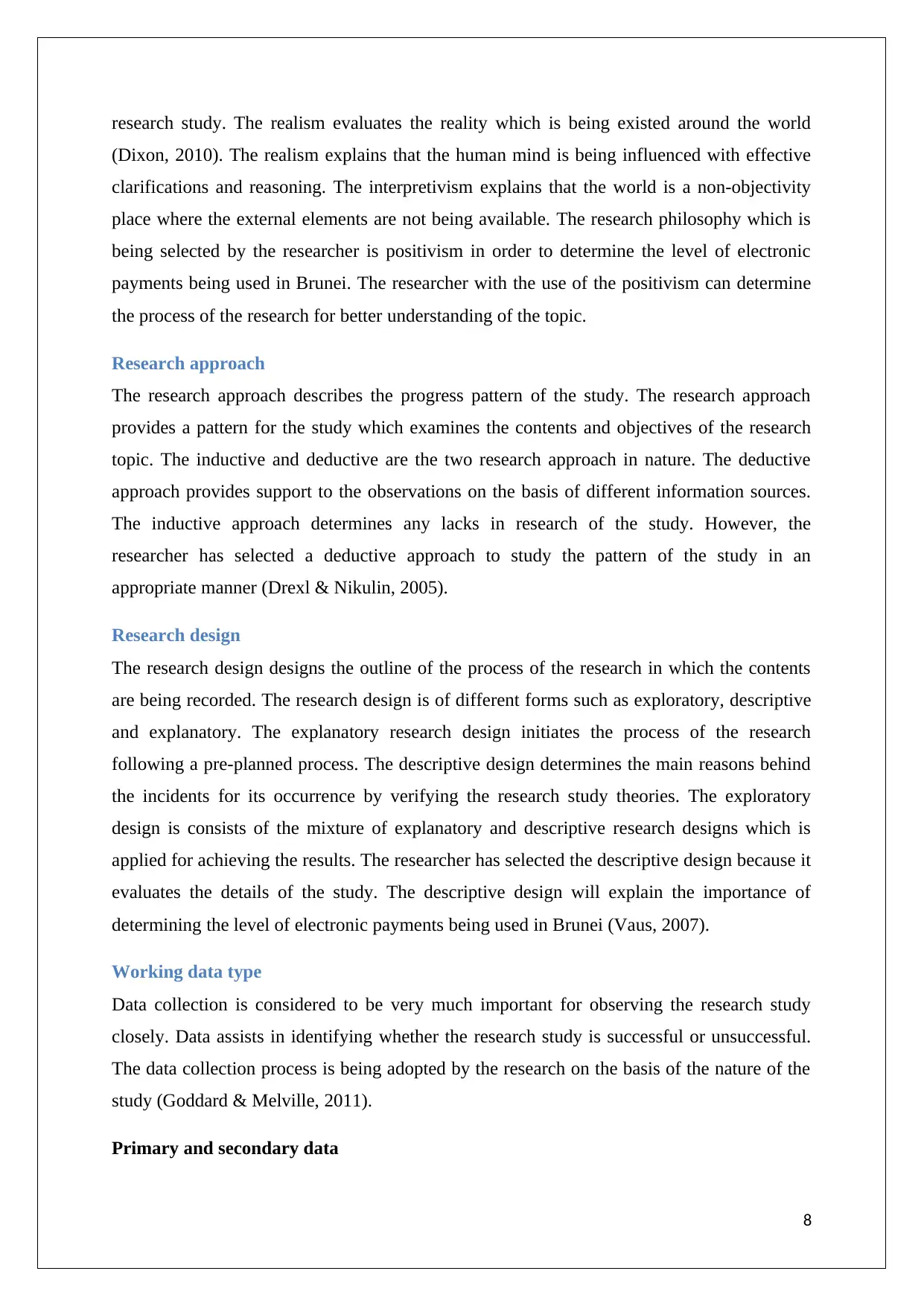
research study. The realism evaluates the reality which is being existed around the world
(Dixon, 2010). The realism explains that the human mind is being influenced with effective
clarifications and reasoning. The interpretivism explains that the world is a non-objectivity
place where the external elements are not being available. The research philosophy which is
being selected by the researcher is positivism in order to determine the level of electronic
payments being used in Brunei. The researcher with the use of the positivism can determine
the process of the research for better understanding of the topic.
Research approach
The research approach describes the progress pattern of the study. The research approach
provides a pattern for the study which examines the contents and objectives of the research
topic. The inductive and deductive are the two research approach in nature. The deductive
approach provides support to the observations on the basis of different information sources.
The inductive approach determines any lacks in research of the study. However, the
researcher has selected a deductive approach to study the pattern of the study in an
appropriate manner (Drexl & Nikulin, 2005).
Research design
The research design designs the outline of the process of the research in which the contents
are being recorded. The research design is of different forms such as exploratory, descriptive
and explanatory. The explanatory research design initiates the process of the research
following a pre-planned process. The descriptive design determines the main reasons behind
the incidents for its occurrence by verifying the research study theories. The exploratory
design is consists of the mixture of explanatory and descriptive research designs which is
applied for achieving the results. The researcher has selected the descriptive design because it
evaluates the details of the study. The descriptive design will explain the importance of
determining the level of electronic payments being used in Brunei (Vaus, 2007).
Working data type
Data collection is considered to be very much important for observing the research study
closely. Data assists in identifying whether the research study is successful or unsuccessful.
The data collection process is being adopted by the research on the basis of the nature of the
study (Goddard & Melville, 2011).
Primary and secondary data
8
(Dixon, 2010). The realism explains that the human mind is being influenced with effective
clarifications and reasoning. The interpretivism explains that the world is a non-objectivity
place where the external elements are not being available. The research philosophy which is
being selected by the researcher is positivism in order to determine the level of electronic
payments being used in Brunei. The researcher with the use of the positivism can determine
the process of the research for better understanding of the topic.
Research approach
The research approach describes the progress pattern of the study. The research approach
provides a pattern for the study which examines the contents and objectives of the research
topic. The inductive and deductive are the two research approach in nature. The deductive
approach provides support to the observations on the basis of different information sources.
The inductive approach determines any lacks in research of the study. However, the
researcher has selected a deductive approach to study the pattern of the study in an
appropriate manner (Drexl & Nikulin, 2005).
Research design
The research design designs the outline of the process of the research in which the contents
are being recorded. The research design is of different forms such as exploratory, descriptive
and explanatory. The explanatory research design initiates the process of the research
following a pre-planned process. The descriptive design determines the main reasons behind
the incidents for its occurrence by verifying the research study theories. The exploratory
design is consists of the mixture of explanatory and descriptive research designs which is
applied for achieving the results. The researcher has selected the descriptive design because it
evaluates the details of the study. The descriptive design will explain the importance of
determining the level of electronic payments being used in Brunei (Vaus, 2007).
Working data type
Data collection is considered to be very much important for observing the research study
closely. Data assists in identifying whether the research study is successful or unsuccessful.
The data collection process is being adopted by the research on the basis of the nature of the
study (Goddard & Melville, 2011).
Primary and secondary data
8
⊘ This is a preview!⊘
Do you want full access?
Subscribe today to unlock all pages.

Trusted by 1+ million students worldwide
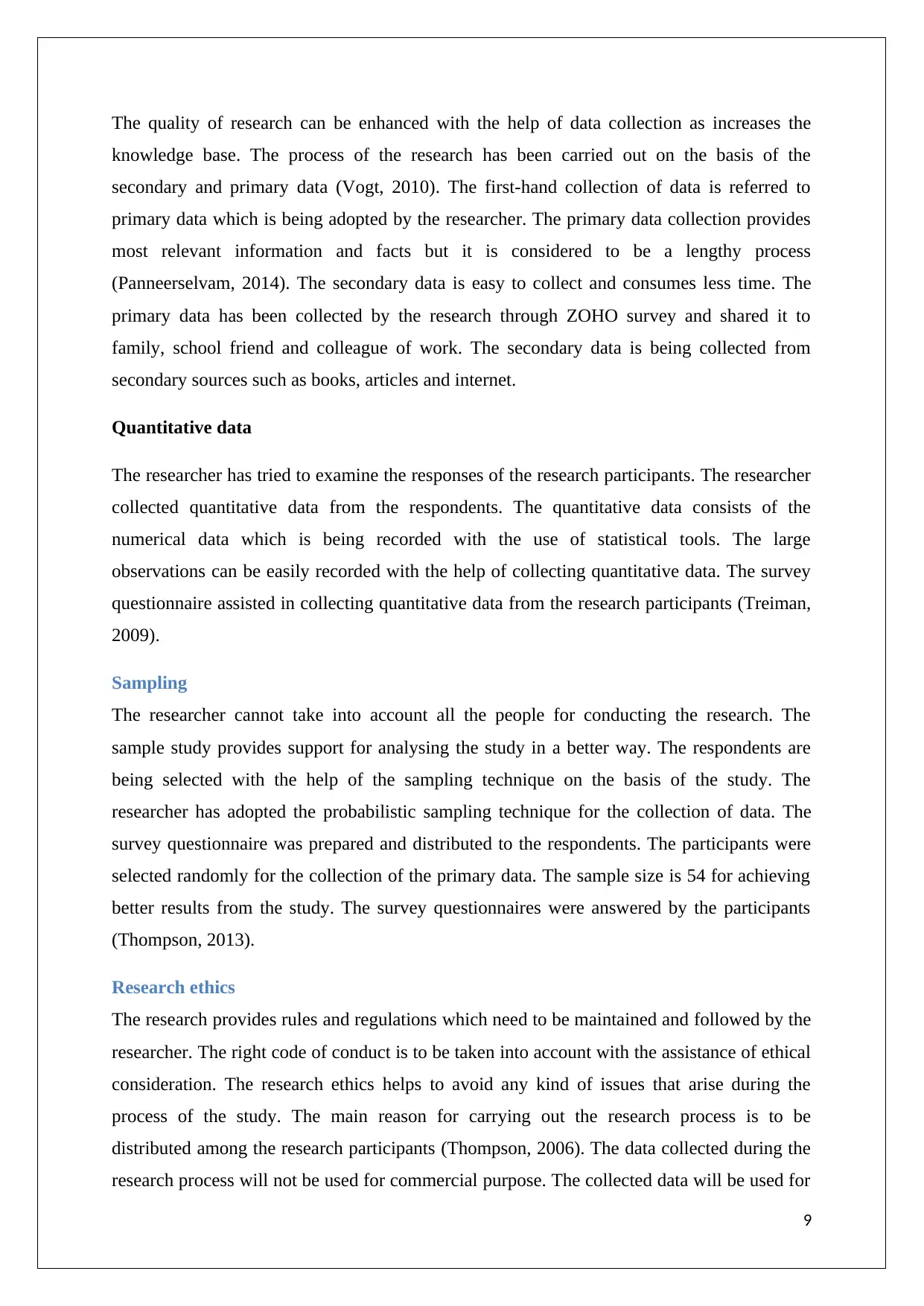
The quality of research can be enhanced with the help of data collection as increases the
knowledge base. The process of the research has been carried out on the basis of the
secondary and primary data (Vogt, 2010). The first-hand collection of data is referred to
primary data which is being adopted by the researcher. The primary data collection provides
most relevant information and facts but it is considered to be a lengthy process
(Panneerselvam, 2014). The secondary data is easy to collect and consumes less time. The
primary data has been collected by the research through ZOHO survey and shared it to
family, school friend and colleague of work. The secondary data is being collected from
secondary sources such as books, articles and internet.
Quantitative data
The researcher has tried to examine the responses of the research participants. The researcher
collected quantitative data from the respondents. The quantitative data consists of the
numerical data which is being recorded with the use of statistical tools. The large
observations can be easily recorded with the help of collecting quantitative data. The survey
questionnaire assisted in collecting quantitative data from the research participants (Treiman,
2009).
Sampling
The researcher cannot take into account all the people for conducting the research. The
sample study provides support for analysing the study in a better way. The respondents are
being selected with the help of the sampling technique on the basis of the study. The
researcher has adopted the probabilistic sampling technique for the collection of data. The
survey questionnaire was prepared and distributed to the respondents. The participants were
selected randomly for the collection of the primary data. The sample size is 54 for achieving
better results from the study. The survey questionnaires were answered by the participants
(Thompson, 2013).
Research ethics
The research provides rules and regulations which need to be maintained and followed by the
researcher. The right code of conduct is to be taken into account with the assistance of ethical
consideration. The research ethics helps to avoid any kind of issues that arise during the
process of the study. The main reason for carrying out the research process is to be
distributed among the research participants (Thompson, 2006). The data collected during the
research process will not be used for commercial purpose. The collected data will be used for
9
knowledge base. The process of the research has been carried out on the basis of the
secondary and primary data (Vogt, 2010). The first-hand collection of data is referred to
primary data which is being adopted by the researcher. The primary data collection provides
most relevant information and facts but it is considered to be a lengthy process
(Panneerselvam, 2014). The secondary data is easy to collect and consumes less time. The
primary data has been collected by the research through ZOHO survey and shared it to
family, school friend and colleague of work. The secondary data is being collected from
secondary sources such as books, articles and internet.
Quantitative data
The researcher has tried to examine the responses of the research participants. The researcher
collected quantitative data from the respondents. The quantitative data consists of the
numerical data which is being recorded with the use of statistical tools. The large
observations can be easily recorded with the help of collecting quantitative data. The survey
questionnaire assisted in collecting quantitative data from the research participants (Treiman,
2009).
Sampling
The researcher cannot take into account all the people for conducting the research. The
sample study provides support for analysing the study in a better way. The respondents are
being selected with the help of the sampling technique on the basis of the study. The
researcher has adopted the probabilistic sampling technique for the collection of data. The
survey questionnaire was prepared and distributed to the respondents. The participants were
selected randomly for the collection of the primary data. The sample size is 54 for achieving
better results from the study. The survey questionnaires were answered by the participants
(Thompson, 2013).
Research ethics
The research provides rules and regulations which need to be maintained and followed by the
researcher. The right code of conduct is to be taken into account with the assistance of ethical
consideration. The research ethics helps to avoid any kind of issues that arise during the
process of the study. The main reason for carrying out the research process is to be
distributed among the research participants (Thompson, 2006). The data collected during the
research process will not be used for commercial purpose. The collected data will be used for
9
Paraphrase This Document
Need a fresh take? Get an instant paraphrase of this document with our AI Paraphraser
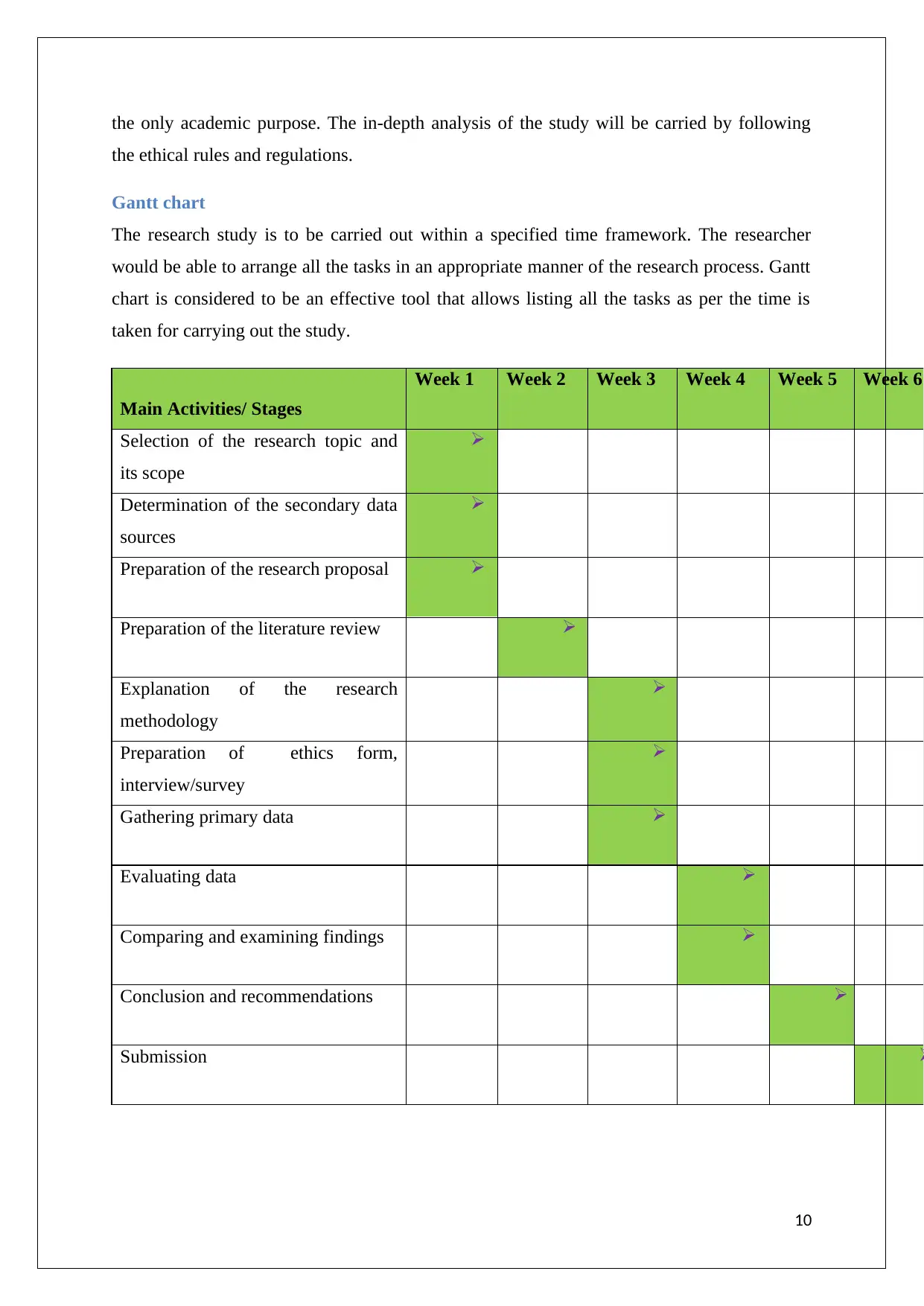
the only academic purpose. The in-depth analysis of the study will be carried by following
the ethical rules and regulations.
Gantt chart
The research study is to be carried out within a specified time framework. The researcher
would be able to arrange all the tasks in an appropriate manner of the research process. Gantt
chart is considered to be an effective tool that allows listing all the tasks as per the time is
taken for carrying out the study.
Main Activities/ Stages
Week 1 Week 2 Week 3 Week 4 Week 5 Week 6
Selection of the research topic and
its scope
Determination of the secondary data
sources
Preparation of the research proposal
Preparation of the literature review
Explanation of the research
methodology
Preparation of ethics form,
interview/survey
Gathering primary data
Evaluating data
Comparing and examining findings
Conclusion and recommendations
Submission
10
the ethical rules and regulations.
Gantt chart
The research study is to be carried out within a specified time framework. The researcher
would be able to arrange all the tasks in an appropriate manner of the research process. Gantt
chart is considered to be an effective tool that allows listing all the tasks as per the time is
taken for carrying out the study.
Main Activities/ Stages
Week 1 Week 2 Week 3 Week 4 Week 5 Week 6
Selection of the research topic and
its scope
Determination of the secondary data
sources
Preparation of the research proposal
Preparation of the literature review
Explanation of the research
methodology
Preparation of ethics form,
interview/survey
Gathering primary data
Evaluating data
Comparing and examining findings
Conclusion and recommendations
Submission
10

The above table depicts the researcher has arranged and listed all the major tasks which are
being needed for conducting the whole research. The tasks are being highlighted which need
to carry out for the accomplishment of the research objectives. The status of the research
study can be determined with the help of the Gantt chart (Welman, Kruger & Mitchell, 2005).
Survey
Question 1
What is your gender?
Question 2
Age range?
Question 3
How much is your monthly income?
Question 4
How many times do you pay using CASH in 2 days?
Question 5
How many times do you pay using Card in 2 days?
Question 6
In the following range, would you prefer to pay use: (You can tick more than one)
Question 7
If it’s possible, which market will you use card? (You can tick more than one)
Data analysis
The data analysis highlights the issue that is being existed in the study. Data analysis is
important for understanding the research study in an appropriate manner. The literature
review theories can be related with the assistance of the data analysis. The primary data has
been collected in form of quantitative from the participants (Sarantakos, 2007).
11
being needed for conducting the whole research. The tasks are being highlighted which need
to carry out for the accomplishment of the research objectives. The status of the research
study can be determined with the help of the Gantt chart (Welman, Kruger & Mitchell, 2005).
Survey
Question 1
What is your gender?
Question 2
Age range?
Question 3
How much is your monthly income?
Question 4
How many times do you pay using CASH in 2 days?
Question 5
How many times do you pay using Card in 2 days?
Question 6
In the following range, would you prefer to pay use: (You can tick more than one)
Question 7
If it’s possible, which market will you use card? (You can tick more than one)
Data analysis
The data analysis highlights the issue that is being existed in the study. Data analysis is
important for understanding the research study in an appropriate manner. The literature
review theories can be related with the assistance of the data analysis. The primary data has
been collected in form of quantitative from the participants (Sarantakos, 2007).
11
⊘ This is a preview!⊘
Do you want full access?
Subscribe today to unlock all pages.

Trusted by 1+ million students worldwide
1 out of 23
Related Documents
Your All-in-One AI-Powered Toolkit for Academic Success.
+13062052269
info@desklib.com
Available 24*7 on WhatsApp / Email
![[object Object]](/_next/static/media/star-bottom.7253800d.svg)
Unlock your academic potential
Copyright © 2020–2025 A2Z Services. All Rights Reserved. Developed and managed by ZUCOL.




